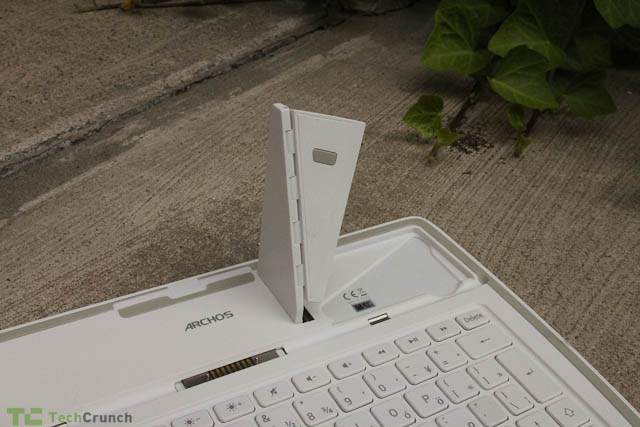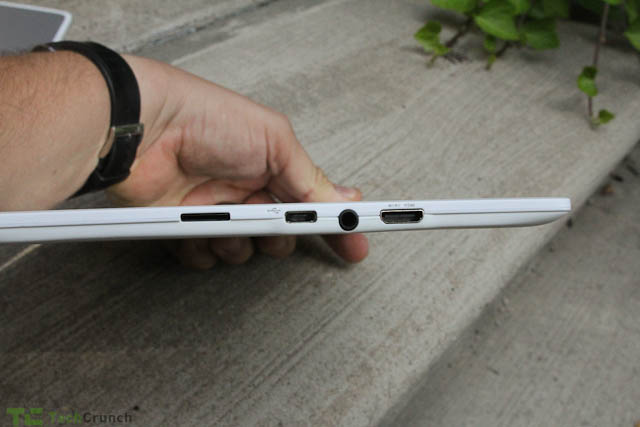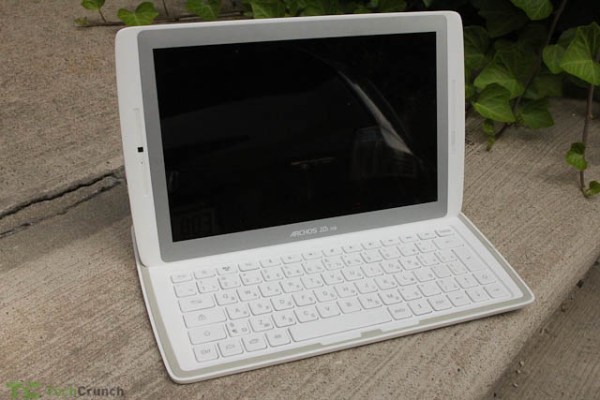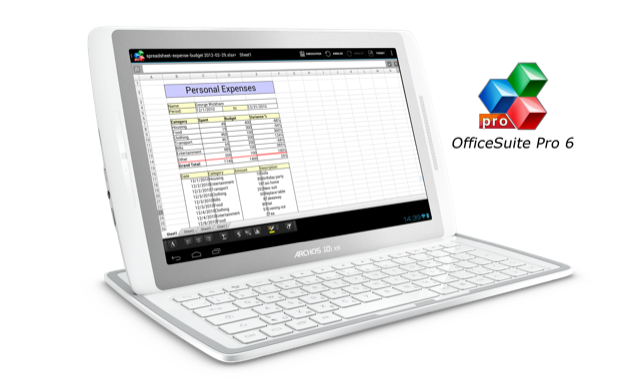Short Version: Want the Microsoft Surface without the Microsoft? Archos may have the device for you. This unique tablet/keyboard combo turns itself from traditional slate into an Android-powered ultralight in a few simple steps. Best of all, it’s going to get Jelly Bean in Q4 2012 so your investment, at least for a few months, will be sound.
The cons? It’s a little chintzy, a little underpowered, and the screen tops out at 1280 x 800 pixels. But can Archos, a stolid and staid tablet maker, create a breakaway hit?
Features:
- Built-in keyboard
- 10-inch LCD screen
- OMAP 4470 CPU with PowerVR SGX544 GPU
- 16GB Storage/MicroSD Slot
- MSRP: $399
Pros:
- Interesting, usable form factor
- Inexpensive laptop replacement
- Slim even with keyboard cover
Cons:
- Doesn’t support Jelly Bean (Android 4.1) yet
- Underpowered for many apps
- Potentially fragile stand mechanism
You’re at your coffee purveyor of choice. You pull out what looks like a white slab of plastic and pull it apart. A few quick movements and you’ve placed one half of the slab on the table and pulled up a small stand. You fit the other half of the slab into an indentation and it connects automatically with powerful magnets. You begin typing as if you were on a real laptop and the customers sitting around you eye you admiringly and a little bit lasciviously. You are the hero of the cafe.
This life could be yours if you pick up the Archos Gen10 101 XS, a $400 tablet from Archos that doubles as a real ultralight laptop. In general, the 101 XS is a run-of-the-mill Android tablet with a twist. The XS joins the Asus Transformer as one of the first tablets to ship with a fully-fledged keyboard that turns the slate into an ultralight notebook in seconds. The question, then, is whether that is a good thing.
In my time with this tablet I’ve come to appreciate the 101 XS in theory if not in practice. Archos has done a great job of integrating the keyboard with this tablet and making it clear that you’re supposed to use this thing in ultralight mode. Powerful magnets hold the keyboard on the screen until you pull them apart and prepare them for docking. You then lift a little leg up out of the keyboard and drop the screen into a groove that is also magnetically active. At this point, the screen is pretty much stuck there until you decide to pull the whole thing apart. You can lift it, swing it around, and even pull it forward. The system will hold.

It is important to note that you must orient the tablet in landscape mode to attach it to the keyboard. You simply can’t stand this up in portrait mode because the edges are slightly rounded and the power and volume buttons are on the right side.
The build quality on the prototype model I tested was very good. The entire thing is clad in white plastic with metal inserts and the entire package fits together seamlessly. I honestly wouldn’t recommend carrying the device without the keyboard as it doesn’t take up much room and it acts as a screen protector when closed. The tablet weighs 21 ounces and is 0.31 inches thick.
The device has an HDMI out as well as microUSB on the side next to a microSD card slot. The keyboard can charge the tablet via a microUSB cable although it does not contain a built-in external battery.

The keyboard itself comes in the standard Chiclet-style that will be familiar to those already using tablet keyboards. There’s not much key travel and all of the keys except for shift, caps lock, enter, space, and tab are the same size. It has a very standard front-facing webcam that is so uninteresting that they don’t even describe its specs. It’s good for video chatting and that’s about it.
The tablet runs a completely stock version of Ice Cream Sandwich and Archos promises upgradability to Jelly Bean at the end of the year. Given the hardware, the system is perfectly serviceable as a text editing and social media machine. Try to do anything else and you’re going to run into problems.
The tablet scored 1379 in Geekbench, which is fairly solid for an Android tablet. Considering the Nexus 7 maxes out at 1600, a score of 1379 should be just fine. Unfortunately, titles like Asphalt 6 HD stuttered during gameplay and the device lagged once you began opening and closing applications.
That’s fine, however, because the package includes OfficeSuite 6.1 Pro, a fairly capable office app that’s compatible with Word and Excel. Here is where the entire thing shines. Coupled with the keyboard you literally have a small word processing machine coupled with a spreadsheet and presentation editor. If you bought this to, say, play HD games, you’re going to be sorely disappointed. If you bought it to do work on the road, you could invest in worse.
The Good
The battery on the 101 XS is good, topping out at about one and a half days of mixed use. This drops precipitously when playing games or watching video but expect a good 5 hours of video time and about a day of regular use as a laptop/slate reader. Archos says they hit about 10 hours of regular web browsing although I saw about 12.
Because the software is bog standard, what we’re really looking at is the hardware and I’m pleased to say the docking system is quite clever and very usable. As an ultralight laptop this thing is more than acceptable for basic office tasks and could replace a very low-end laptop in your bag.
It’s a clever, cool convertible tablet that attests to Archos’ willingness to experiment in the space.
The Bad
Archos is really good at making solid, boring devices. For years they made PMPs (until that market fell through) and now they make tablets. The 101 XS is clearly a flagship device this year but I worry that folks looking at other tablets – including the iPad – will find less to love in this one. First the screen is acceptable, but is built at such a low resolution that any other tablet looks amazing in comparison. Sure, there are plenty of 1280 x 800 pixel screens out there and at the price it’s still a good deal. However, if I’m going to be staring at a screen for hours editing and writing, I’d prefer a bit higher resolution.
Availability will also anger many. The device will be available in Europe in mid-September and then North America in November. By that time this thing will be an also-ran. Considering the planned Jelly Bean upgrade won’t happen until Q4 holidays I suspect Asus, HTC, and Samsung will run circles around this device, not to mention the Microsoft Surface which lands in October.
The 101 XS, then, feels like an experiment. It’s a successful one, to be clear, but its rarely wise to invest in a company’s trial balloon. I have a feeling that Surface-style devices will be the Next Big Thing™ in CE and this is just the beginning.
The model I used exhibited a few problems. For one, the metal skin scratched quite easily. A varnish will be applied to final versions to prevent this, but it was pretty egregious. The build quality is solid but nothing special. It’s not going to fall apart on you, but it’s not going to win any beauty contests.
You can also recreate this device with an iPad quite easily with a Keyboard cover. Although Archos will argue that you pay more to outfit an iPad like this, you also get more. The screen is better and the iWork apps are notably superior. Similar keyboards can be had for almost any Android tablet out there, including the Nexus 7. Arguably this case/tablet combo exists in a contiguous whole, so that’s a benefit.
The Bottom Line
It almost feels as if any overt recommendation would be moot in this case as the tablet will be facing stiff competition in the U.S. next quarter. However, if you’re in Europe feel free to check it out and compare it to similar offerings from other tablet manufacturers. It’s a bit underpowered but the price – a low $399 – and size make it a very interesting alternative to even an ultralight laptop with similar processor firepower.
The experiment here is a success. It’s up to you to decide whether this form factor is something you’re looking for in a tablet, especially considering upcoming alternatives in the space. I could definitely see myself using it on a short weekend trip if I had some Word work to do but beyond documents, presentations, and some spreadsheets, you may want to look elsewhere.


